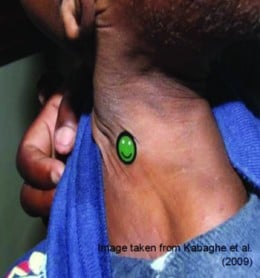Thermospot Temperature Indicator

Problem being addressed[edit | edit source]
Hypothermia is a leading cause of infant death in developing countries. Thermometers can be expensive and some require electricity or batteries, which can be a difficult burden on the user. There is currently no low-cost method for continuous monitoring of an infant's body temperature.
Detailed description of the solution[edit | edit source]
Thermospot is a low-cost, reusable hypothermia indicator designed particularly for use by illiterate mothers. It is a small, flexible sticker with a smiley face to be applied to the infant or child's skin. The LCD screen on the sticker changes color in accordance with the infant's core temperature. It is green with a smiley face when core temperature is between normal limits of between 36.5 and 37.5oC. The color varies from light green with a smiley face to red with a smiley face to all black to indicate severe hypothermia. The color also changes to blue to indicate a fever.
Designed by[edit | edit source]
- Designed by: John Zeal in the mid-1990s (original design)
- Manufacturing: worldwide. It can be purchased at Maternova.net
When and where it was tested/implemented[edit | edit source]
Thermo-spot has been field-tested for more than a decade in several locations including Northern India and Malawi. It is available for sale for less than 8 US cents, and the cost is expected to decrease with mass implementation. This device is now currently available for purchase.
Funding Source[edit | edit source]
Clinical studies were funded by the Bill and Melinda Gates Foundation and Save the Children. The Johns Hopkins School of Public Health has also contributed to this product's development.
References[edit | edit source]
Peer-reviewed publication[edit | edit source]
Green, D. A., Kumar, A., & Khanna, R. (2006). Neonatal hypothermia detection by ThermoSpot in indian urban slum dwellings. Archives of Disease in Childhood.Fetal and Neonatal Edition, 91(2), F96-8.
Kambarami, R., Chidede, O., & Pereira, N. (2002). ThermoSpot in the detection of neonatal hypothermia. Annals of Tropical Paediatrics, 22(3), 219-223.
Kennedy, N., Gondwe, L., & Morley, D. C. (2000). Temperature monitoring with ThermoSpots in Malawi. Lancet, 355(9212), 1364.
Kumar, V., Mohanty, S., Kumar, A., Misra, R. P., Santosham, M., Awasthi, S., et al. Saksham Study Group. (2008). Effect of community-based behaviour change management on neonatal mortality in Shivgarh, Uttar Pradesh, India: A cluster-randomised controlled trial. Lancet, 372(9644), 1151-1162.
Morrice, J., Manda, L., & Kacheche, A. (2003). Hypothermia and the use of Thermospots. Trop Doct., 33(4), 253.
Pejaver, R. K., Nisarga, R., & Gowda, B. (2004). Temperature monitoring in newborns using ThermoSpot. Indian Journal of Pediatrics, 71(9), 795-796.
Other internally generated reports[edit | edit source]
Zeal J & Fripp R. Introducing the ThermoSpot a non-invasive hypothermia indicator for newborns, infants and children. Online brochure available here.
Externally generated reports[edit | edit source]
BBC News. (2005.) Fading smile could save babies. Link available here.
Maternova. (2011.) Thermaspot Temperature Indicator. Link available here.
Approval by regulatory bodies or standards boards[edit | edit source]
CE approval